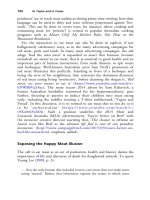The palgrave international handbook of a 232
Bạn đang xem bản rút gọn của tài liệu. Xem và tải ngay bản đầy đủ của tài liệu tại đây (28.23 KB, 1 trang )
International Trade in Animals and Animal Parts
227
IWT can be conceptualised as consisting of three basic stages—poaching/
collecting/harvesting; smuggling; selling. Admittedly, in some cases, there is
also a processing or manufacturing stage that takes place. Whereas the first
stage has some element of opportunity to it—a person happens upon wildlife
which they kill or kidnap for profit—the other stages need to be more
organised to ensure success. This is fulfilled by both structured or organised
criminal actors and also organised crime groups (Wyatt 2013c). The latter
are drawn to IWT in increasing numbers because of a variety of factors.
Profit entices organised criminals into particular black markets. Certain
wildlife markets are very profitable, and in turn, there is evidence that organised
crime plays a role here. For example, organised crime is documented in the
smuggling of caviar and whale meat, as well as rhino horn—all of which are
highly profitable (Wyatt 2013c). Other factors which are favourable for
organised crime are the scarcity or abundance of the wildlife. Endangered or
rare wildlife are typically worth more, and therefore, offer more profit for
organised crime groups who have the resources to access these species—the
trade in rhinos exemplifies this. In contrast, other more prevalent wildlife
markets, like that in fur-bearing mammals or pangolins, may be organised in
the sense the trafficking is structured, but this is not necessarily facilitated by
organised crime groups (Wyatt 2013c). Another factor affecting the involvement of organised crime is the location of the wildlife habitat in relation to the
location of the consumer. If the two are in close proximity, the smuggling is
fairly straightforward and handled by local people. In contrast, if there is a
considerable distance between the two—as in the rhino in Africa and the use of
the horn in Asia—smuggling is much more organised and risky. Wyatt (2013c)
argues this more complicated dangerous trafficking is undertaken by organised
crime groups who are experienced and sophisticated enough to be successful.
Since organised crime’s primary objective is profit presumably animal welfare is
not taken into consideration during capture or smuggling as discussed further
below. Also to ensure profit, if possible it makes sense to smuggle large
quantities of wildlife to guarantee some survive to be sold. This might mean
increased numbers of victimised animals. This victimisation is outlined below.
Nature
Each stage of trade potentially harms and/or injures the wildlife victim. This
section will explore such harm and injury during capture, smuggling and
killing. It should be noted that even farmed or captive wildlife bred for the
trade face abuse and that abuse and suffering extends beyond transportation









